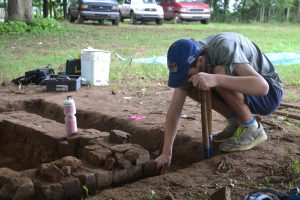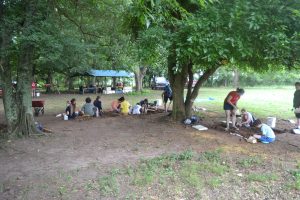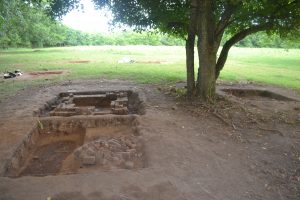
TUSCALOOSA, Ala. — It started with a tombstone, but that one simple grave marker was the stepping stone for a group of University of Alabama archaeologists and their eager workers, teams of middle- and high-school students, who discovered a small piece of early plantation life in Alabama.
For the past four years, UA’s Office of Archaeological Research has worked with Auburn resident Charles Weissinger to investigate his ancestral home site and cemetery. Weissinger is the descendant of Johann Georg Weissinger (who later “Americanized” his name to George) who migrated to the United States from Germany between 1782 and 1784.
In January 1820, about a month after Alabama was admitted to the Union, George purchased about 1,700 acres of land in Perry County to establish a plantation. Between then and the early 20th century, when the home was destroyed by fire, three families occupied the site — the Weissinger, Davis and Fuller families.
About 50 years ago, Weissinger was given the tombstone of his great-great-grandfather, who had died in 1837. The tombstone had come from the ancestral property; George and several family members and possibly one member of the Davis family are interred somewhere on the land. For years, the self-described historian had been carrying the tombstone with him whenever he moved to a new place.
“I wanted to put it back in the ground, in its original location,” Weissinger said. “I wanted to find the cemetery. But to do that, I needed to find the house.”

Organizers decided the project would be a great fit for the 36th Expedition of UA’s Alabama Museum of Natural History. The annual museum expedition involved 36 participants (13 during middle-school week, 14 during high-school week and nine during public camp) over the course of three June weeks.
While the mornings were dedicated to working with researchers in the field and then helping analyze what was discovered, the afternoons were reserved for fun, including activities like swimming, canoeing or taking nature walks.
“We know that teachers do a great job of preparing students in the classroom, but often times what is overlooked is the hands-on experience,” said Randy Mecredy, director of UA’s Alabama Museum of Natural History. “The Expedition is an important opportunity, especially for high-school and middle-school students, to take part in a real hands-on field science project and work side-by-side with scientists.
The research goals for this year’s expedition were to confirm the location and investigate the house site; determine its size and layout; analyze the artifacts recovered during the excavations; and attempt to locate the cemetery using ground-penetrating radar and hand-excavation methods.
“So, we have rural plantation archaeology, attempting to discover an early 19th Century home and cemetery, that has a Civil War veteran connection, using technology such as ground-penetrating radar and three-dimensional computer models,” said Brandon Thompson, cultural resources investigator with UA’s Office of Archaeological Research.
In addition to finding the exact house location, its approximate orientation and evidence that it was burned and demolished, Thompson said they also recovered artifacts that date from the early 19th to early 20th century, including spirit and pharmaceutical bottle glass, nails used in the house’s construction, charred timbers, fragments of dishes and plates, children’s marbles, doll fragments and cutlery.
“These artifacts provide insight into the activities that were taking place, including many activities that we still do today, such as cooking and playing games,” he said. “The preservation was better than what I had expected.”

After the home was destroyed in the early 20th century, the area had been used for pasture and agriculture, but a chimney foundation and other architectural features were in remarkable shape, Thompson said.
In terms of artifacts, one of the high-school Expedition campers, Aislinn Hardin, recovered a Confederate Infantryman’s uniform button during the excavations, which Thompson said can be associated with a member of the Davis family, who had purchased the property in the mid-19th century from the Weissingers and occupied it until the early 20th century.
“Hugh Davis Jr. fought for the Confederacy at the Battle of the Missionary Ridge in Chattanooga, Tennessee, in 1863,” Thompson said. “After being wounded in the battle, Hugh Davis Jr. returned to the home to recover and manage the estate. So, being able to find an artifact and associate it with a specific person and event is remarkable.”
Davis Jr. had a younger brother, Albert, who also fought for the Confederacy as an enlisted man, Weissinger said.
The recovered artifacts are now being analyzed at the Office of Archaeological Research laboratory at UA’s Moundville Archaeological Park. They will be stored for future study and possible display.
The cemetery, however, has not been found, but Weissinger has not given up hope. Office of Archaeological Research staff will continue the investigation and excavation of the site in an effort to unearth the wealth of information that is still left to gain.
“This is a puzzle that must be solved,” Weissinger said. “It’s a piece of history, and history is important for all of us to know. It’s a perfect guide for our future.”
Contact
Kim Eaton, UA media relations, 808/640-5912, kkeaton@ur.ua.edu
Source
Brandon Thompson 205/371-2266, brandon.s.thompson@ua.edu; Randy Mecredy, 205/348-2136, rmecredy@bama.ua.edu; Charles Weissinger, 334/524-4122, chasweissinger@gmail.com